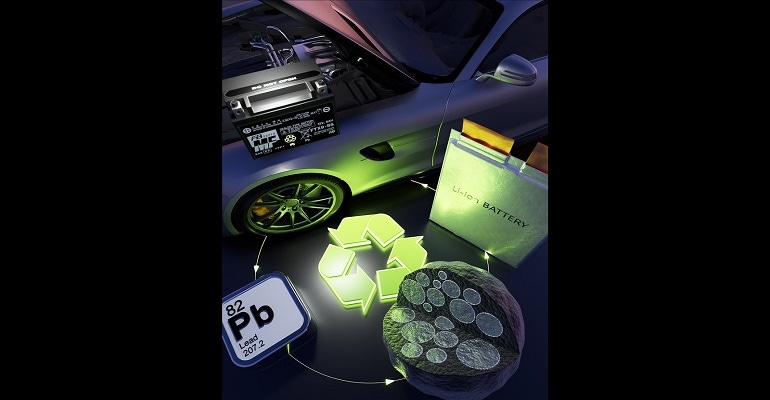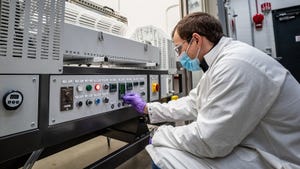Lead Anodes Developed for Lithium-Ion Batteries
An inexpensive lead anode has been developed for use in lithium-ion batteries.
March 11, 2021

Lead acid batteries have been used as starting batteries and to provide electrical power in automobiles for well over 100 years. Lead-based batteries are inexpensive to manufacture, provide high cranking power necessary for cold starts, and exhibit an adequate number of charge and discharge cycles to provide a reasonable operational life. Lead-acid batteries also have a very high recycling rate—more than 99% in the US.
Unfortunately, the high weight of a lead acid battery and its relatively low capacity for energy storage means that they have been passed over in favor of much more energy intense lithium-ion batteries for applications like electric vehicles (EV). More recently, lighter weight lithium-ion batteries are even beginning to replace lead-acid batteries in their traditional automotive roles in internal combustion engine (ICE) vehicles.
Lead As An Anode
This has many in the battery industry looking for new applications for lead. Scientists from the U.S. Department of Energy’s (DOE) Argonne National Laboratory (ANL) have reported on a new electrode design for lithium-ion batteries using the low-cost lead as well as carbon in an anode to replace the presently used carbon graphite.
“Our research has exciting implications for designing low-cost, high-performance, sustainable lithium-ion batteries that can power hybrid and all-electric vehicles,” said Eungje Lee, principal author and materials scientist in Argonne’s Chemical Sciences and Engineering (CSE) division in an ANL news release.
Lithium-ion batteries work by insertion of lithium ions into the graphite sheets of the anode during charging (a process called intercalation), and the removal of lithium ions during discharge. Graphite anodes have very little dimensional change during the intercalation process and can operate for thousands of charge-discharge cycles. Unfortunately, it is beginning to appear that graphite anodes have reached their limit in terms of energy storage capacity, leading to the search for alternative materials.
“We decided to investigate lead as an intriguing alternative to graphite for the anode material,” said Lee.
In addition to being abundant and inexpensive, lead has a well-established supply chain due to the long history of lead-acid batteries in automobiles.
“Our new anode could offer a new revenue stream for the large industry currently engaged in lead-acid battery manufacturing and recycling,” Lee added.
Shaking Microscopic Particles
The ANL team built its anode from microscopic particles within an intricate structure. Lead nanoparticles are embedded in a carbon matrix and enclosed by a thin lead oxide shell. The team also invented a simple, low-cost method for fabricating the complex structure.
“Our method involves shaking, for several hours, large lead oxide particles mixed with carbon powder until they form microscopic particles with the desired core-shell structure,” explained Christopher Johnson, the principal investigator of the project and an Argonne Distinguished Fellow in the CSE division.
The researchers investigated the charge-discharge mechanism of their anode at the GeoSoilEnviro Center for Advanced Radiation Sources (GSECARS), operated by the University of Chicago, at Argonne’s Advanced Photon Source, a DOE Office of Science User Facility. Synchrotron X-ray diffraction allowed them to track the changes in phases of the anode material while it was being charged and discharged.
Promising Results
Charge and discharge cycling showed that the new lead-based nanocomposite anode “…attained twice the energy storage capacity of current graphite anodes (normalized for the same weight).” The small particle size alleviated stresses normally created during cycling while the carbon matrix allowed electrical conductivity and “…acted as a buffer against damaging volume expansion during cycling.” The ANL team found that adding a small amount of fluoroethylene carbonate to the standard electrolyte also significantly improved the test cell’s performance.
The team discovered a previously unknown electrochemical reaction between lead and lithium ions that occurs upon charge and discharge.
“This fundamental insight may prove important in understanding the reaction mechanism of not only lead but also silicon anodes,” said Lee.
Silicon anodes are another low-cost, high-performance candidate that is under intense research for next-generation lithium-ion batteries.
“Our discovery challenges the current understanding of this type of electrode material,” noted Johnson. �“Our findings also provide exciting implications for designing low-cost, high-performance anode materials for transportation and stationary energy storage, such as backup power for the electric grid.”
Kevin Clemens is a Senior Editor with Battery Technology.
About the Author(s)
You May Also Like





